By Howard Schneider, Leika Kihara, Balazs Koranyi and William Schomberg
Central bankers, who once considered obscurity central to their craft, are trying to wean the world from the predictability they've nurtured over 15 years of concrete guidance about their intentions and return to a time when policy starts, stops and occasional surprises were more the norm.
The endeavor is driven by recognition that renewed inflation may require higher and more frequently changed interest rates than has been the case since 2007, when a U.S. financial crisis opened an era of strong and often detailed central bank guidance that spanned the near crack-up of the euro zone, sluggish growth, an oil slump, pandemic and war.
"Communication comes with a cost of misinterpretation, and it also may limit flexibility," Federal Reserve Chair Jerome Powell said at a Fed forum last month. "We should use forward guidance sparingly when the course of policy is either reasonably well understood, or, on the contrary, is so dependent on uncertain future developments that little really can be said constructively about the future."
The current moment qualifies as that, with developed world central banks still trying to corral the worst inflation in 40 years, edging policy rates towards a level that will do the job but uncertain where that point may be or how their local economies will react.
FITS AND STARTS
The effort by policymakers to dial back the clock - to a time when they talked about risks and outlooks but did less to pin down the path of monetary policy - is off to a fitful start.
The Reserve Bank of Australia and the Bank of Canada showed the emerging model last week when, with little to no advance effort to steer public expectations, they resumed rate increases after inflation proved more persistent than anticipated. Both had held rates steady since earlier in the year.
The Bank of England in February removed its explicit guidance and tied decisions to inflation data. As prices continued to climb, investors duly priced in more rate increases, and with the outlook so unclear BOE Governor Andrew Bailey has simply avoided steering them in another direction.
The Bank of Japan, by contrast, still battling to raise perennially weak inflation, has left the core part of its guidance intact with a pledge to "patiently" sustain loose policies. Still, in a small but significant shift it has softened its promise to keep a wide variety of interest rates at "current or lower levels."
The European Central Bank says it has adopted a "meeting-by-meeting" approach with "a strong preference against returning to outright forward guidance on policy rates." But as a practical matter officials have provided such a strong steer - a "directional bias" they call it - that markets have put nearly a 100% probability on a rate increase at the June 15 meeting. A long list of individual policymakers have said rates should rise in July, too.
The Fed, meanwhile, faces a tricky moment at its meeting this week.
Though Powell in May warned that the strongest forms of forward guidance aren't useful when officials are less certain about the outlook, U.S. central bankers at their June 13-14 meeting will still have to release quarterly projections that include point estimates of the federal funds rate at year's end.
DOT PLOT THICKENS
Meant as a tool for transparency to show how officials feel the economy is likely to evolve, the so-called dot plot is often construed as rate guidance, a situation former Fed Chair Ben Bernanke said was "not ideal" for policymakers who don't want to tie themselves down.
"People don't understand the difference all the time between a commitment and a forecast," Bernanke said at last month's forum alongside Powell.
If the projections show the policy rate moving up later this year, officials will likely face questions if they do as expected and hold rates steady at the June meeting. If the rate is not seen moving up, they will face questions about not being responsive to recent data showing strong inflation despite pledging to be "data dependent."
"Walking the optionality tightrope won't be easy," said EY-Parthenon Chief Economist Gregory Daco. "There is some element of cognitive dissonance in waiting...to tighten policy if it's necessary today."
That "dissonance" may become more common if investors and analysts end up, as they are now, in a will-they-or-won't-they debate ahead of each Fed meeting.
But it isn't necessarily a bad thing. After 15 years of sequential crises, it may mark a return to normal.
The current tightening cycle, St. Louis Fed President James Bullard told Reuters earlier this year, is a "return to kind of ordinary monetary policy...Data's coming in and it's indicating that you should go up or down and you would do that appropriately - more like you might have seen in the 90s," when central bank communications were more constrained.
(Reporting by Howard Schneider; Editing by Dan Burns and Andrea Ricci)









